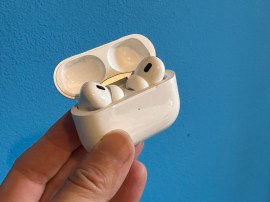17 best Apple reveals ever: just ‘one more thing’…
iPod! iMac! iPhone! iPad! — and also some things not starting with ‘i’! - Apple reveals on stage have always been great

Before we all became terribly jaded by having upcoming Apple smartphone rumors relentlessly smashed into our eyeballs on a regular basis, Apple events were full of genuine surprises. And even in recent years, Apple has provided the odd shock, either through somehow keeping things secret or by going above and beyond the speculation. Here are our best Apple reveals.
We’ve scoured Apple’s history to find our favourite moments of Apple-oriented astonishment, showmanship, and that phrase that once sent chills down the backs of every Apple fan: “one more thing…”
Steve Jobs WWDC Q&A (1997)
In 1997, Apple was actually beleaguered, and Steve Jobs had returned as a consultant, having yet to become interim CEO, or ‘iCEO’. At WWDC, his Q&A with developers was at odds with corporate presentations of the time. Surprising in its humanity, this event within an event showcased where Apple would head over the next decade.
Bill Gates looms large (1997)
As Apple made its comeback, Steve Jobs announced a partnership with Microsoft. “Boo!” jeered the crowd. Jobs continued. “Cross-licensing!” BOOO! “Apple has decided to make Internet Explorer the default browser on the Macintosh…” BOOOOO! Adding to the comic theatricality, Bill Gates appeared in giant video form, looming over Jobs. It felt like an omen. But Jobs was prescient: “We have to let go of this notion that for Apple to win, Microsoft has to lose.”
iMac (1998)
Under a year after a new management team took over Apple, Jobs outlined a sharply focussed consumer grid: one ‘desktop’ and ‘portable’ product each for ‘consumer’ and ‘pro’ customers. The consumer desktop became iMac, which Jobs said arrived from “the marriage of the excitement of the internet with the simplicity of Macintosh”. No longer were all computers boring beige boxes. Some PC manufacturers didn’t quite get it, though, laughably welding bits of translucent coloured plastic to said beige boxes. It became one of the most iconic computers of all time.
iBook (1999)
The final ‘blank square’ in Apple’s grid, the consumer portable, was filled with what customers had demanded: an “iMac to go”. In hindsight, the dinky notebook looked a bit like a candy-coloured toilet seat, but at the time you were dead inside if you weren’t wowed and surprised. (And, as ‘one more thing’, Jobs noted it was wireless, too.)
OS X (2000)
Despite the internet’s increasing popularity (in part through the iMac), Apple still managed to keep some things secret, including the majority of OS X. Jobs showed it off in a surprisingly utilitarian demo, but there were plenty of gasps when he used the Dock’s magnification and minimisation.
No more iCEO (2000)
After two and a half years of Jobs being Apple’s ‘interim’ CEO, he dropped the ‘interim’ bit. OS X got big cheers that day, but the biggest was reserved for the moment everyone realised Jobs was sticking around for the long term.
G4 Cube (2000)
Apple expanded its product matrix with a new desktop machine that aimed to combine the clout of the PowerMac with the elegance, silence and miniaturisation from the iMac. Images had circulated online, but Apple’s lawyers got all lawyery, meaning the gorgeous unit — possibly Apple’s finest in that regard — still surprised many when unveiled.
iPod (2001)
Rumours had swirled, but Apple largely managed to keep wraps on its ultra-portable player. The same size as a deck of cards, the iPod could hold 1000 songs, had a more advanced battery than Apple used in its notebooks, and boasted effortless navigation. Pundits griped about the price, but Apple had made the first steps in revolutionising another industry. And there was another iPod-related surprise the following year: Windows support.
Now, of course, we know the iPod is to be no more with the most recent iPod touch being the last. Here’s our guide to the best iPod designs. And why we’re sad about it.
iMac G4 (2002)
This one was ruined a bit by the Canadian edition of Time running a photo of the computer on its cover the day before Apple’s keynote; nonetheless, the audience was still gobsmacked by marrying Pixar’s Luxo with sawing the back off of an iMac. You half expected it to start hopping about the place and playing with squeaky balls.
The Intel switch (2005)
Rumours had rattled around that Apple was about to get into bed with Intel, but it was nonetheless a shocker when Jobs said on stage this was true. There were no boos this time, given that the PowerPCs inside the day’s Macs had gone from toasting Intel to being toasted themselves. Now Apple has almost dumped Intel, of course, by transitioning to its own Apple Silicon.
iPhone (2007)
We all knew an Apple phone was happening, but Jobs wrongfooted the audience at Macworld 2007 by saying Apple was introducing three revolutionary products: a widescreen iPod with touch controls; a revolutionary mobile phone; and a breakthrough internet communications device. “Are you getting it,” asked Jobs to rapturous applause. “These are not three separate devices. This is one device. And we are calling it iPhone.”
MacBook Air (2008)
After spending a bit of time demolishing the competition for accepting too many compromises in ultra-portables, Steve Jobs noted Apple’s new MacBook Air fitted inside “one of these envelopes we’ve all seen floating around the office”. And then he pulled the new computer out of one. People guessed Apple had a new notebook in the works, but not how insanely thin it would be. The best Apple reveal apart from the iPhone. For sure.
FaceTime (2010)
Apple wasn’t the first company to offer video calls, but FaceTime on its demo wowed and surprised the audience with its set-up-free elegance and simplicity. Probably the biggest surprise, though, was Apple stating FaceTime would be ‘open’. This sadly never came to pass, but the ‘open’ idea was tucked away for the future.
iPad (2010)
Despite the best attempts of a certain tech site to ruin the surprise, few people had seen the iPad. All people knew was it probably looked like a huge iPhone. In the event, it did in fact look like a huge iPhone, and it broadly worked like one too. But the intuitive interface married with a larger display gave everyone a vision of the future of computing.
Mac Pro (2013)
By 2013, the Mac Pro had become synonymous with ongoing disappointment, and rumours suggested Apple might kill the line entirely, until the company unusually confirmed it was planning something “really different”. The result was a tiny bit Darth Wastebasket, but it was certainly very different.
“Can’t innovate any more, my ass,” exclaimed SVP Phil Schiller, before noting the new Mac Pro was unlike anything Apple had ever made. It was state of the art but oddly tiny — almost vindication for the Cube, and without doubt proof Apple could still surprise.
Of course, the Mac Pro looks a little different now, and we have Mac Studio, too.
The U2 invasion (2014)
Not all surprises are welcome. In 2014, Apple made the misstep of welding U2’s Songs of Innocence to every iTunes library, whether you wanted it or not. Even some U2 fans who might have been overjoyed were shocked to find it nestled among other purchases. Many wondered if they’d been hacked; we thought it akin to spam. Apple later provided a tool for removing the album entirely from your iTunes account, although sadly not from the world at large.
ResearchKit (2015)
Not all surprises are about shiny gadgets. In fact, Apple would argue its primary goal has always been the intersection of humanity and technology. In its March 2015 keynote, this was in evidence through a new framework, ResearchKit. This offered surprise upon surprise: Apple entering medical research; the scope of the system and the speed with which it could potentially help people worldwide; the way software and an iPhone could record fine details regarding relevant patient input and medical data; and ResearchKit being made open source. (No FaceTime-style U-turn this time!) We hope you enjoyed our guide to the best Apple reveals.
- Also check out: Every iPhone ranked in order of greatness



